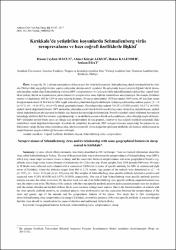| dc.contributor.author | Macun, Hasan Ceyhun | |
| dc.contributor.author | Azkur, Ahmet Kürşat | |
| dc.contributor.author | Kalender, Hakan | |
| dc.contributor.author | Erat, Serkan | |
| dc.date.accessioned | 2020-06-25T14:33:21Z | |
| dc.date.available | 2020-06-25T14:33:21Z | |
| dc.date.issued | 2017 | |
| dc.identifier.citation | Macun, H. C., Azkur, A. K., Kalender, H., Erat, S. (2017). Kırıkkale'de yetiştirilen koyunlarda Schmallenberg virüs seroprevalansı ve bazı coğrafi özelliklerle ilişkisi*. Ankara Üniversitesi Veteriner Fakültesi Dergisi, 64(2), 93 - 97. | en_US |
| dc.identifier.issn | 1300-0861 | |
| dc.identifier.issn | 1308-2817 | |
| dc.identifier.uri | https://app.trdizin.gov.tr/publication/paper/detail/TWpJd01EUTNOdz09 | |
| dc.identifier.uri | https://hdl.handle.net/20.500.12587/379 | |
| dc.description.abstract | Avrupa'da 2011 yılında ruminantları etkileyen yeni bir virüs belirlenmiştir. Schmallenberg olarak isimlendirilen bu virüsün Türkiye'deki yaygınlığı üzerine yapılan çalışmalar oldukça sınırlı sayıdadır. Bu çalışmada; koyun yetiştiriciliğinde büyük ekonomik kayıplara neden olan Schmallenberg virüsün (SBV) seroprevalansı ve Culicoides'lerle nakledilmesinden dolayı bazı coğrafi özellikler (rakım, büyük su kaynaklarına yakın olması) ile seroprevalans arası ilişkinin araştırılması amaçlanmıştır. Bu amaçla, Kırıkkale merkez ve ilçelerinde, 684 ile 1219 m arası rakımda bulunan, 38 koyun sürüsündeki 1038 hayvandan (969 koyun, 69 koç) kan serum örneği alınarak ticari ELISA kiti ile SBV özgül antikorları yönünden değerlendirilmiştir. Çalışmaya alınan hayvanların yaşları 2 - 4 (n517), 4 - 6 (n474), 6 (n47) olarak gruplandırılmıştır. Örneklenen hayvanların %0.38'i (4/1038) pozitif, %0.57'si (6/1038) şüpheli olarak değerlendirilmiştir. SBV antikorları yönünden pozitif olarak belirlenen dört hayvanın birinin koç, üçünün koyun; şüpheli olarak değerlendirilen altı hayvanın ise birinin koç, beşinin koyun olduğu belirlenmiştir. Pozitif ve şüpheli olarak belirlenen hayvanların bulunduğu sürülerin belli bir rakımda yoğunlaşmadığı ve bu sürülerin yarısının büyük su kaynaklarına yakın olmadığı tespit edilmiştir. SBV yönünden pozitif örnek sayısı az olduğu için seroprevalansı ile yaş grupları, cinsiyet ve bazı coğrafi özellikler arasındaki ilişki istatistiksel olarak değerlendirilmemiştir. Kırıkkale'de yetiştirilen koyunlarda, SBV seroprevalansının araştırıldığı bu çalışma ile enfeksiyonun varlığı ilk kez ortaya konulmuş olup, abortus/anomalili yavru doğumları gözlenen sürülerde, söz konusu enfeksiyonun da araştırılmasının uygun olabileceği kanısına varılmıştır. | en_US |
| dc.description.abstract | A virus, which effects ruminants, was firstly described in 2011 in Europe. There are limited information about this virus called Schmallenberg in Turkey. The aim of the present study was to determine the seroprevalance of Schmallenberg virus (SBV), which may cause major economic losses to sheep, and the association between seroprevalance and some geographical features (e.g. altitude, near a large water source) because of transmission by Culicoides spp. Blood samples from 1038 animals (969 ewes, 69 rams) in 38 flocks were collected and evaluated with a commercial ELISA kit in terms of specific antibody for SBV in centrum and eight towns of Kirikkale, where the altitudes ranges from 684 to 1219 meters. Age groups of the animals were determined as >2 - <4 (n 517), >4 - <6 (n 474) and >6 (n 47) years old. The samples of Schmallenberg virus specific antibody detected as positive and suspected were 0.38% (4/1038) and 0.57% (6/1038), respectively. One out of four Schmallenberg virus specific antibody positive animals was ram, the others were ewes. On the other hand, one out of six Schmallenberg virus specific antibody suspected animals was ram, the others were ewes. The flocks of the animals with the virus specific antibody positive and suspected animals were not in places with the certain altitudes and the half of those flocks were not close to large water sources. Due to the limited numbers of animals with the virus specific antibody positive, no statistical analysis were performed to see the association between the seroprevalance of the virus and gender, age of the animals and the geographical features of the places. This study that is first investigation about Schmallenberg virus seroprevalence in sheep in Kirikkale, showed the presence of the virus specific antibody. It was also thought that this virus should be considered as the cause of abortion and malformed births in flocks. | en_US |
| dc.language.iso | tur | en_US |
| dc.rights | info:eu-repo/semantics/openAccess | en_US |
| dc.subject | Veterinerlik | en_US |
| dc.title | Kırıkkale'de yetiştirilen koyunlarda Schmallenberg virüs seroprevalansı ve bazı coğrafi özelliklerle ilişkisi* | en_US |
| dc.title.alternative | Seroprevalance of Schmallenberg virus and its relationship with some geographical features in sheep reared in Kirikkale* | en_US |
| dc.type | article | en_US |
| dc.contributor.department | Kırıkkale Üniversitesi | en_US |
| dc.identifier.volume | 64 | en_US |
| dc.identifier.issue | 2 | en_US |
| dc.identifier.startpage | 93 | en_US |
| dc.identifier.endpage | 97 | en_US |
| dc.relation.journal | Ankara Üniversitesi Veteriner Fakültesi Dergisi | en_US |
| dc.relation.publicationcategory | Makale - Ulusal Hakemli Dergi - Kurum Öğretim Elemanı | en_US |
















